Transition Studies 33
"average negroes possess too little intellect, self-reliance and self-control to make it possible for them to sustain the burden of any respectable form of civilisation without a large measure of external guidance and support. The Chinaman is a being of another kind, who is endowed with a remarkable aptitude for a high material civilisation. He is seen to the least advantage in his own country, where a temporary dark age still prevails, which has not sapped the genius of the race, though it has stunted the development of each member of it, by the rigid enforcement of an effete system of classical education, which treats originality as a social crime' The natural capacity of the Chinaman shows itself by the success with which, notwithstanding his timidity, he competes with strangers, wherever he may reside. The Chinese emigrants possess an extraordinary instinct for political and social organisation; they contrive to establish for themselves a police and internal government, and they give no trouble to their rulers so long as they are left to manage these matters for themselves."
"The history of the world tells a tale of the continual displacement of populations, each by a worthier successor, and humanity gains thereby. We ourselves are no descendants of the aborigines of Britain, and our colonists were invaders of the regions they now occupy as their lawful home. But the countries into which the Anglo-Saxon race can be transfused are restricted to those where the climate is temperate. The tropics are not for us to inhabit permanently; the greater part of Africa is the heritage of a people differently constituted to ourselves. On that continent, as elsewhere, one population continually drives out another. We note how Arab, Tuarick, Fellatab, Negroes of uncounted varieties, Caffre and Hottentot surge and reel to and fro in the struggle for existence. It is into this free fight among all present that I wish to see a new competitor introduced-namely the Chinaman. The gain would be immense to the whole civilised world if he were to outbreed and finally displace the negro, as completely as the latter has displaced the aborigines of the West Indies. The magnitude of the gain may be partly estimated by making the converse supposition-namely the loss that would ensue if China were somehow to be depopulated and restocked by negroes."
Whatever opinion we may bold of Galton's views on the Chinaman, there is no doubt that this passage marks not only his full acceptance of the doctrine of the survival of the fitter race as applied to man, but further his opinion that civilised man could himself directly expedite the processes of evolution.
A few further memoirs having a bearing on geographical or allied topics may be noted here. We have already referred to his views on maps. In 1865 the idea occurred to Galton that, as maps so conspicuously fail to give us the leading features of a mountainous country and- are indeed so incapable of representing crags and cliffs successfully, a stereoscopic photograph of a model would be of extreme value'. Indeed a coloured model on this plan with reproduction by colour photography might go a long way to satisfy Galton's craving for something more illustrative of the floral and geological environment than an ordinary map can provide. He suggests what might be done in this way by photography of the models of the English Lakes at Keswick, of the Pyrenees at Luchon, and of the Alps at Berne, Zurich, Lucerne and Geneva. With the assistance of Mr R. Cameron Galton he was able to obtain and exhibit stereoscopic photographs of the following models
(1) Island of St Paul in the Indian Ocean', from an Austrian bronze model.
' Was this sentence a thrust at another race, and was Galton thinking of his own bitter experience? See Vol. i, pp. 12, 142.
2 "On Stereoscopic Maps taken from Models of Mountainous Countries," R. Geog. Soc. Journal, 1865, pp. 99-106.
a Midway on Mercator's chart between Melbourne and Cape Town.
ran 15

